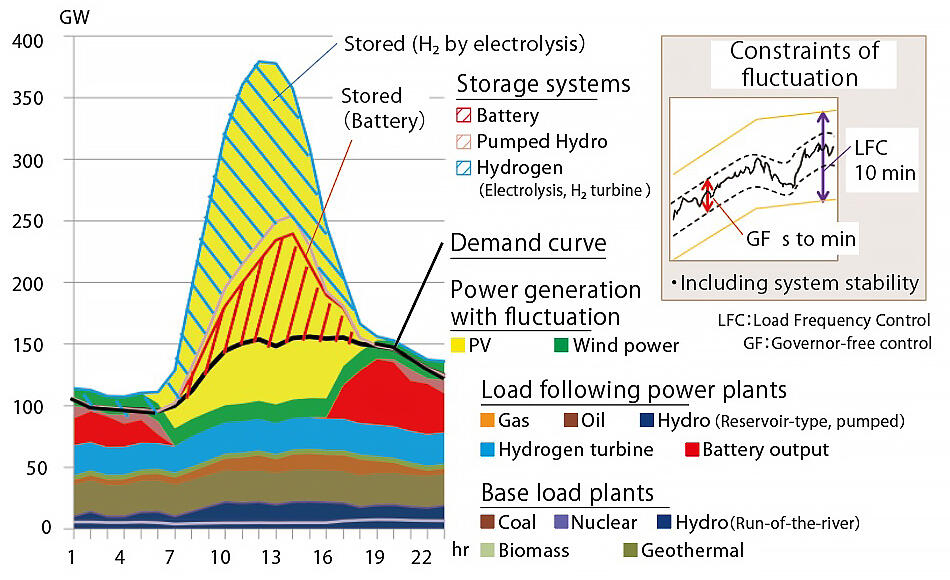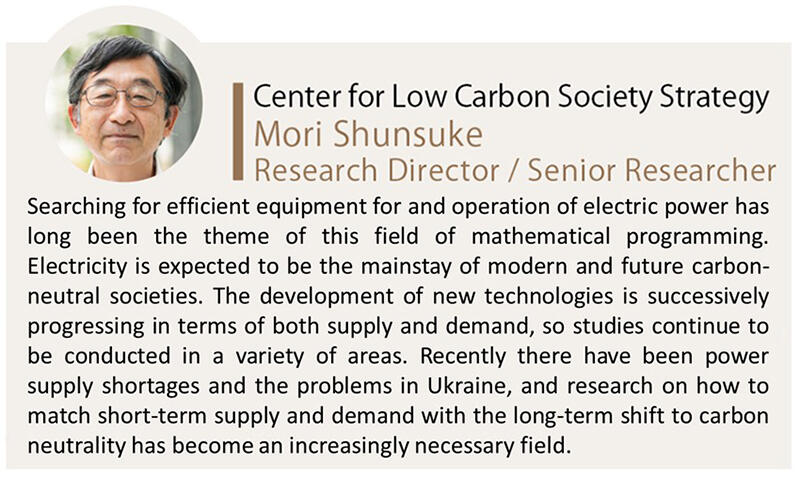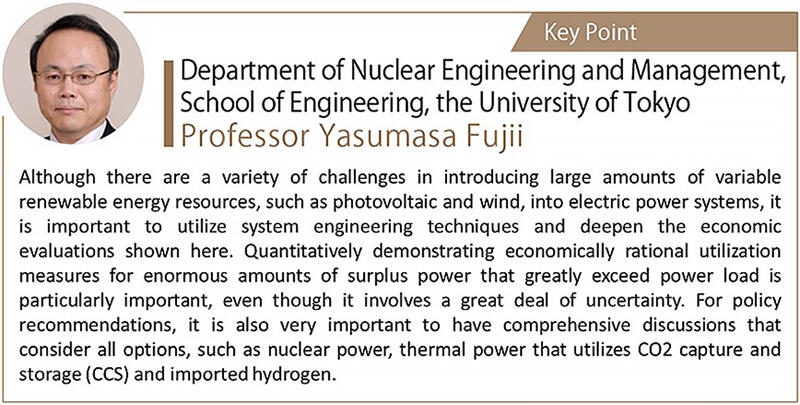This is the fourth installment in a series of stories in which Yutaka Minakawa, a young employee of a trading company, reads and analyzes proposal papers by the Center for Low Carbon Society Strategy (LCS). In the previous installment, Minakawa learned about the possibilities and challenges of biomass energy from LCS researchers Hiroshi Iwasaki and Satoko Kawarasaki. In this installment, Minakawa interviews Visiting Researcher Toshihiro Inoue and Researcher Makoto Furuki, who are researching power generation mix scenarios at the LCS for achieving carbon neutrality, about the prospects for realizing a "bright and affluent zero-emissions society."
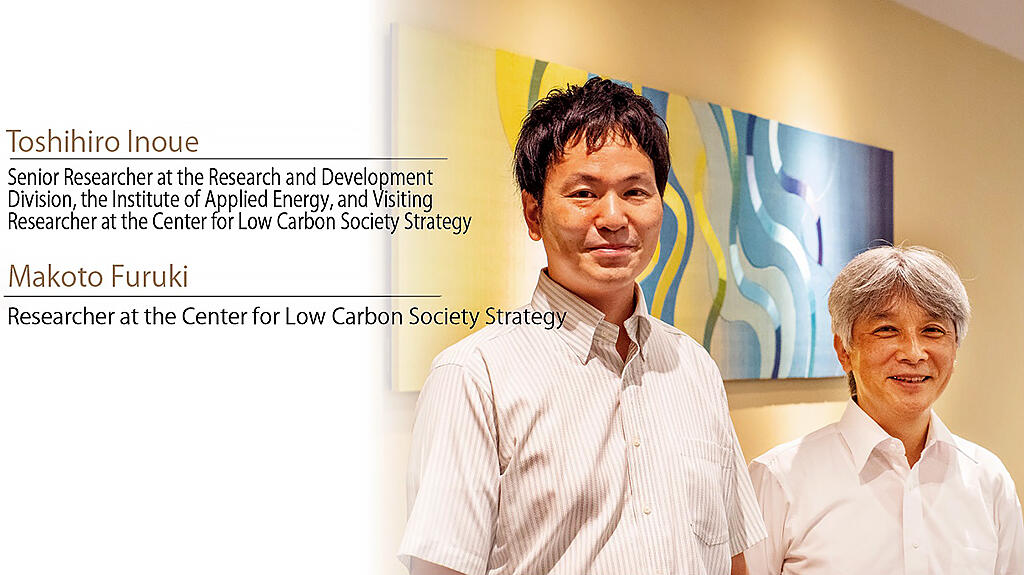
A reasonable, zero-carbon future ― Deriving optimal solutions from multivariable equations
Minakawa: Thank you for talking with me today. Recently, there has been a trend towards not only governments, but also private businesses tackling global issues. My company also wants to keep up with the decarbonization business, but some of the people in my company are deeply skeptical about achieving carbon neutrality and fear that it will put pressure on people's lives and on businesses, so we haven't taken any steps yet. Therefore, I came to talk with you and learn about how you are researching a vision of the future that is both carbon neutral and economically reasonable.
Inoue: I see. We often receive this opinion, but if we do not think negatively from the beginning and include cost reductions due to technological progress, we can create a vision of a feasible society.
Furuki: Specifically, take a look at the table (Table 1) that summarizes our research results. At the top of the table, we initially set the target year, the carbon dioxide (CO2) reduction rate, and the power demand, and then we calculated the most economically rational allocation of power supplies and adjustment technologies for each condition. In doing so, if power demand is within the range of around twice the current level, then we found that there are solutions that can maintain power generation costs at about their current levels even if the CO2 reduction rate in 2050 is 100%.
Minakawa: So even if carbon-neutral is achieved in the future, it is possible that there will not be a significant increase in the burden on household budgets or on businesses. However, there are so many variables, and some people might think that you just came up with convenient numbers.
Furuki: Well then, let me briefly explain. First, our technology team investigates and considers technologies then builds a scenario that reflects future technological achievements. Next, the entire power system, from power generation, such as solar power, to transmission and consumption, is constructed as a model that consists of numerous variables with the technology scenario as a prerequisite. The conditions include zero or upper limits on the use of some of the configurations. Finally, this is used to derive a cost-minimizing solution from the multiple equations.
Our intentions are not included in the calculation itself, so the same answer should be produced no matter who does the calculations. Additionally, we also calculated using an electricity demand that has a higher value than what the government is currently forecasting. Even so, as in cases 2 and 3, we still obtained results showing that a 100% CO2 reduction ratio can be achieved in 2050.
Predicting future technological achievements ― Developing to achieve goals
Minakawa: Looking at the level of future technological achievement, is that anticipating that technologies under development will be achieved around that time?
Inoue: It's a bit different from that. There is steady and rapid progress in energy-related technologies, and there are continued increases in the power generation efficiency of renewable energy and in power consumption efficiency, including for air conditioning. Therefore, we go back to the constraints of the laws of physics to consider necessary and feasible technological advances and to predict the degree of future technological achievement. Governments and others have announced their prospects for realizing a decarbonized society, but the unique point of the LCS scenarios is that they present a variety of science-based technology scenarios that are based on the premise of technologies that can be achieved in the future. That is why, for example, power storage capacity in our scenarios is quite large when compared to the forecasts from other institutions.
Minakawa: Looking closely, I can see that power demand has significantly increased in Case 3. Why did you consider this scenario, even with the development of energy-saving technologies and the expected population decline in Japan?
Furuki: The first reason is that more electricity than ever before will be needed for Japan to remain competitive in AI and other IT technologies. The other reason is more substantial, because, in order to achieve carbon neutrality, we will eventually have to electrify a considerable amount of our energy with the exclusion of some areas that are difficult to do, such as aircraft.
Minakawa: Heating and the supply of hot water, which have mainly used fossil fuels, will inevitably be electrified if we try to make them carbon neutral. So, in other words, much of the energy demand that has been counted as "non-electricity" is included in "electricity."
Inoue: Energy carriers, such as biomass, hydrogen, and ammonia are also expected, but it is clear that electrification ratios need to increase.
Table 1: Example power generation mix in 2030 and 2050
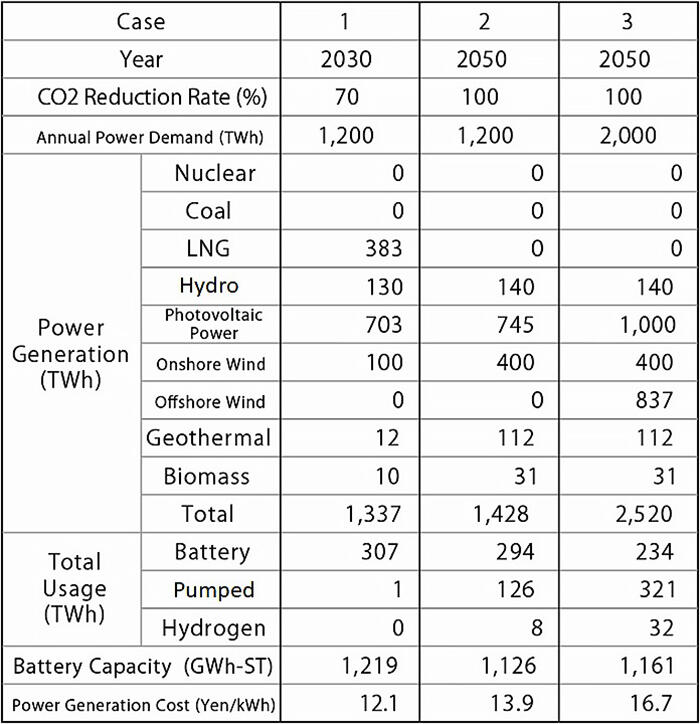
Usage that fluctuates by season and time: Making use of inter-regional interconnectors and storage batteries
Minakawa: I see. If we can move forward with investments in a planned manner and achieve an electric power system that matches this scenario, then Japan's future sure looks bright, doesn't it?
Inoue: I'd would say so, but you can't give a generalized explanation just by looking at the power generation mix. First, there is an assumption that the power system must generate and consume the same amount of electricity in the same time period. If this balance collapses, then large-scale power outages will occur. However, renewable energy mainstays such as solar power and wind power are dependent on the weather and the wind.
On the other hand, power demand greatly fluctuates depending on the time of day, the season, and the weather. You have to balance volatile power generation with fluctuating power demand. Additionally, there are concerns that reducing thermal power generation, which has supported conventional AC power systems, and making solar power and wind power into primary power sources will destabilize the power system and increase the risk of large-scale power outages. (Fig. 1).
Minakawa: So it's not enough to just have sufficient total power generation, and it's difficult to bring freely-adjustable thermal power generation to zero.
Furuki: The key to this is power transmission. We need to mobilize all of the volatile power sources scattered throughout Japan and to flexibly distribute power from places where there is a surplus to places where there is a shortage. Regions rich in renewable energy resources such as Hokkaido, Tohoku, and Kyushu are unevenly distributed away from large power consumption areas. For a long time, power grids have been governed by the supply areas of the major electric power companies (formerly known as General Electric Utilities), and cross-regional transmission lines across the areas have been used to provide flexibility. We believe that we need more massive reinforcement for the large-scale introduction of renewable energy.
Minakawa: And power storage technologies will be another key, right?
Furuki: If the power grid is a technology for sharing power over an area, then power storage is technology for sharing power over time. Renewable energy power plants can temporarily store the excess power that they often generate and then release it when there is a power shortage to stabilize the power supply. Because this power will be discharged when the price of electricity is high, I think that it will also be possible to create a model that is viable from a business point of view. Specifically, technologies that have been put into practical use include pumped storage hydropower, lead and lithium-ion batteries, and hydrogen electrolysis. Ryuzo Asada, Research Group Leader at LCS, is knowledgeable about new pumped-storage power.
Minakawa: Thank you very much for speaking with me today about power generation mixes and your vision for the future.
* This is a fictional narrative based on an interview.
(Text and photos by Tomokazu Fukui)
Fig. 1: Daily power demand and power generation (80% reduction in CO2 emissions in 2050 -- example of hourly output on a summer weekday)
